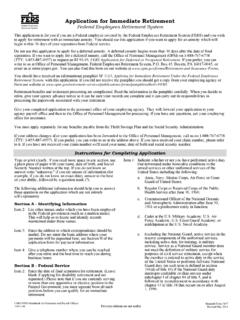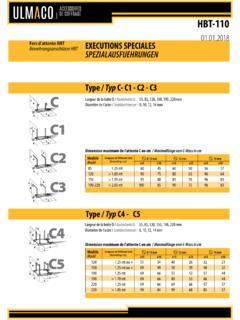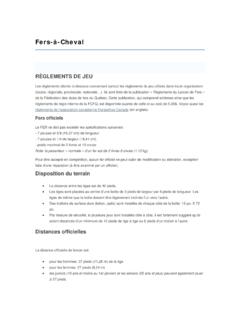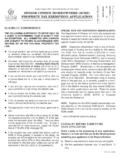Transcription of Periodization Strategies - TreinamentoEsportivo
1 National Strength & Conditioning Association Volume 25, Number 6, page 19 37. Periodization Strategies Steven S. Plisk, MS, CSCS,*D. Velocity Sports Performance Trumbull, Connecticut Michael H. Stone, PhD. Olympic Committee Colorado Springs, Colorado Keywords: mean; method; strategy; tactic AUTHORS' NOTE: THE ISSUE OF translate well. This has made over the short term, especially in program planning is based on pro- some straightforward issues ap- previously trained subjects. Sec- fessional practice knowledge, pear complicated and has alienat- ond, optimal results are achieved rather than scientific evidence. Al- ed its share of coaches or athletes. by manipulating training vari- though an effort is made to pre- The intent of this article is ables in appropriate sequence(s). sent relevant research findings threefold: (a) to relate periodiza- and combination(s), rather than where appropriate, most of the tion to a familiar idea (game theo- simply accomplishing a given concepts discussed in this article ry); (b) to discuss the decision- amount of work.
2 Our objective in are intuitive or anecdotal. making challenges involved in this article is to discuss the prac- designing periodized training pro- tical issues involved in applying grams; and (c) to present some ex- these conclusions. Many strength and conditioning amples of applied Strategies . Note practitioners have embraced peri- that there are definite gaps in our Periodization and Game odization theory over the last two current knowledge because peri- Theory decades. Different interpretations odization theory is based largely On one hand, Periodization can be are now commonly applied in on empirical evidence; related defined as planned distribution or practice and discussed in profes- ( , overtraining) research; and a variation in training methods and sional publications or meetings. few mesocycle-length variation means on a cyclic or periodic basis Yet despite its popularity, some studies. Most of these involved ex- (1, 8, 11, 17, 18, 20, 27, 38, 39, people still seem to struggle with perimental periods no longer than 53, 58, 60, 67, 68, 81, 87, 88).
3 The the concept. Periodization origi- 2 3 months and/or subjects with basic goals are to exploit comple- nated in Eastern Europe, and limited training experience, mentary training effects at optimal therefore is perceived by many in whereas no actual multiple-meso- times, manage fatigue, and pre- the West as a foreign idea (refer to cycle or integrated studies ( , vent stagnation or overtraining. Siff [58] and Graham [20] for his- combined strength/power and This involves long-term, interme- torical reviews). Although this has speed/endurance training) on ad- diate, and short-term planning. enhanced its mystique, the con- vanced athletes have been pub- Accordingly, periodized training cept often seems disconnected lished in English. programs are typically structured from our knowledge and experi- Nevertheless, the available into macro-, meso-, and microcy- ence. Likewise, a working under- evidence supports two conclu- cles that progress from extensive standing of Periodization involves sions (67, 68): first, Periodization to intensive workloads as well as a fair bit of scientific theory and seems to be a superior approach general to special tasks.
4 Corre- jargon, some of which may not to strength/power training even sponding decisions should be December 2003 Strength and Conditioning Journal 19. Table 1. Continuum of Classic Training Methods for Specialized Strength Development Maximal strength Brief maximal efforts [intra/intermuscular coordination; rate of force development]. Relative intensity: 75 100%. Action speed: slow to explosive Volume: 15 25 reps/session @ 95 100%; 20 40 reps/session @ 90 95%; 35 85 reps/session 80 90%;70 110 rps/session @ 75 80% ( 8 reps/set for low skill movements; 3 reps/set for high skill movements). Density: full (up to 8 min) recovery between sets Repeated submaximal efforts [hypertrophy]. Relative intensity: 80 90%. Action speed: slow to explosive Volume: 5 10 sets per exercise Density: 1 4 min recovery between sets; 24 48 hours between sessions Combination methods Speed-strength Submaximal accelerative efforts [power; rate of force development].
5 Relative intensity: 30 85%. Action speed: explosive/maximal Volume: 3 7 sets per exercise; 1 3 reps/set @ 85%; 3 5 reps/set @ 80 85%; 5 8 reps/set @ 70 80%;. 8 15 reps/set @ <70%. Density: 2 8 min recovery between sets; daily sessions Reactive-ballistic efforts [stretch-shortening cycle; stiffness regulation]. Contrast methods [acute after -effects; potentiation]. Strength-endurance Extensive interval [low/moderate intensity endurance capacity; recoverability]. Relative intensity: 30 40%. Action speed: brisk/continuous Volume: 3 6 sets per exercise; 20 30 reps per set Density: <5 min recovery between sets Intensive interval [high intensity endurance capacity; recoverability]. Relative intensity: 50 60%. Action speed: explosive Volume: 3 6 sets per exercise; 20 45 second duration per set (rep count is irrelevant). Density: 1 3 min recovery between sets Note: Objectives are indicated in brackets. Source: Plisk (50, ).
6 Made with respect to several fac- theory came of age a half century games ( , chess, poker) were tors, including the biological re- later when John Nash, John first applied to economics. Its play- sponses to training stimuli, the Harsanyi, and Reinhard Selten like connotations do not do justice athlete's developmental status, shared the 1994 Nobel prize for to the real-world significance of and the specific demands of his or their pioneering analysis of game game theory. Since mathematician her sport. theory as a foundation for under- John Von Neumann and econo- Game theory, on the other standing complex economic is- mist Oskar Morgenstern first pub- hand, is the science of strategic sues.) This theory originated when lished their Theory of Games and thinking (5, 7, 9, 10, 26). (Game the principles of certain parlor Economic Behavior (86), its novel 20 Strength and Conditioning Journal December 2003.
7 Insights and diverse applications your adversary from effectively ploits certain physiological re- have made game theory enor- countering your tactics. This in- sponses and achieves specific ob- mously important. In fact, it has volves a randomized plan intend- jectives. The first step in the plan- evolved into a unified field theory ed to thwart an opponent's ability ning process is to classify one's used to explain and predict many to anticipate your next move or training tactics into a rational sys- phenomena in the social sciences. concentrate its resources at a sin- tem. Tables 1 and 2 outline two Note that a game is any situation gle point of attack. As Dixit and reasonable taxonomies of strength of strategic interdependence where Nalebuff (10) put it, The right and endurance development one player's decisions or actions amount of unpredictability should methods, respectively, that can be interact with another's.
8 Such not be left to chance (p. 170). used as a sort of playbook. These games can be very real, the players The essence of periodized pro- schemes reflect general agreement need not be persons, and their in- gram design is to skillfully com- in the literature, making them teractions need not be adversarial. bine different training methods in useful examples. Indeed, convergence, not conflict, order to yield better results than In light of recent economic of interest is the rule, rather than can be achieved through exclusive events, modern portfolio theory of- the exception, in many circum- or disproportionate use of any 1 of fers an instructive and timely les- stances. Therein lies the relevance them. To use a baseball analogy, son as well. (This theory was for- of this concept to training program an adept pitcher uses off-speed mally introduced by Markowitz design. pitches ( , breaking ball, (37); he shared the 1990 Nobel In terms of game theory, peri- change-up) to set up his or her prize with Merton Miller and odization is the use of planned un- fastball, rather than relying on a William Sharpe for their pioneer- predictability to manipulate or single tactic even a dominant ing work in the theory of financial outmaneuver another player.)
9 The one. Likewise, strength and condi- economics.) Contrary to the gam- other player in this case is the tioning professionals can use a bling venture it is sometimes be- body's adaptive mechanism. The mixed methods strategy that ex- lieved to be, there is a science to underlying goals are to influence your counterpart to adjust or redi- rect its actions in probable ways and prevent it from accommodat- ing your tendencies. This brings us to a critical distinction: in con- trast to athletics, where a compet- itive strategy is used to achieve a win-lose outcome, the key in training is a cooperative strategy aimed at a win-win result. Al- though the basic principle of game theory applies in either case, com- plementing, rather than defeating, another player is the strategy of choice in this situation. In this sense, Periodization is a form of coopetition (5, 46). Coaching Strategy Coaching is often described as the science of total preparation.
10 In some respects ( , game plan- ning, play calling), it can also be Figure 1. Fitness-fatigue theory. An athlete's preparedness is determined by the described as the art of systematic summation of positive (fitness) and negative (fatigue) responses. In con- unpredictability. The trick is to trast to the supercompensation theory based on a cause-and-effect re- lationship between these two processes, this model proposes that im- mix your plays with no demon- mediate training effects are characterized by their opposing action. strable pattern in order to prevent Reprinted by permission from Zatsiorsky (92, p. 16). December 2003 Strength and Conditioning Journal 21. investment finance. A central paradigm (Figure 1; 92). According Note that rational program de- premise of this theory is that asset to this theory, an athlete's pre- sign is one prong of a restoration allocation is the main determinant paredness is defined as the sum- plan that should also address nutri- of portfolio performance.






